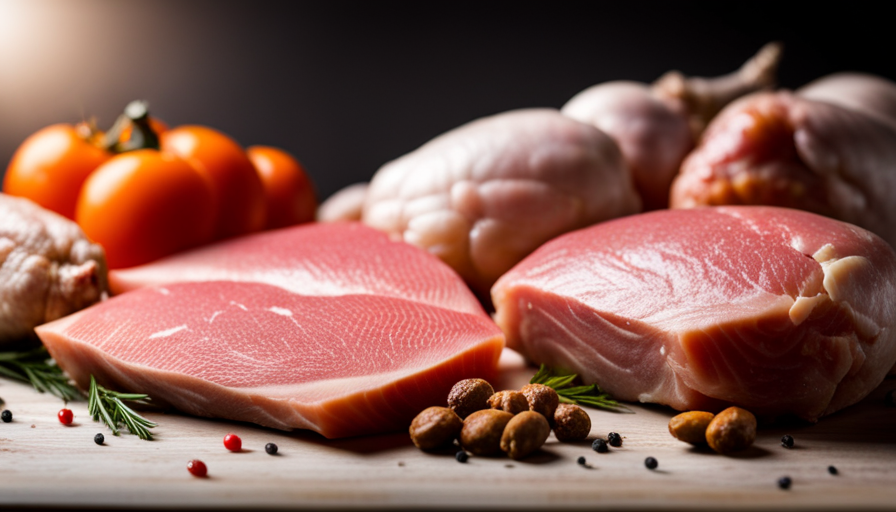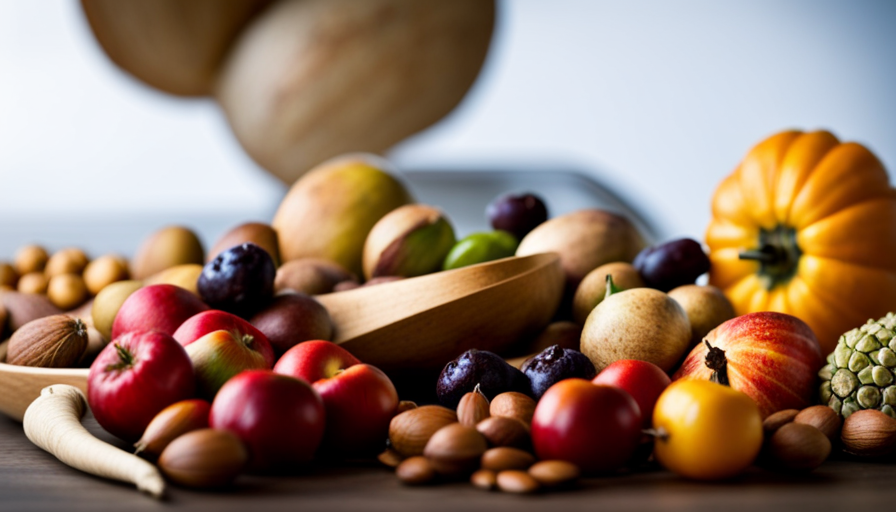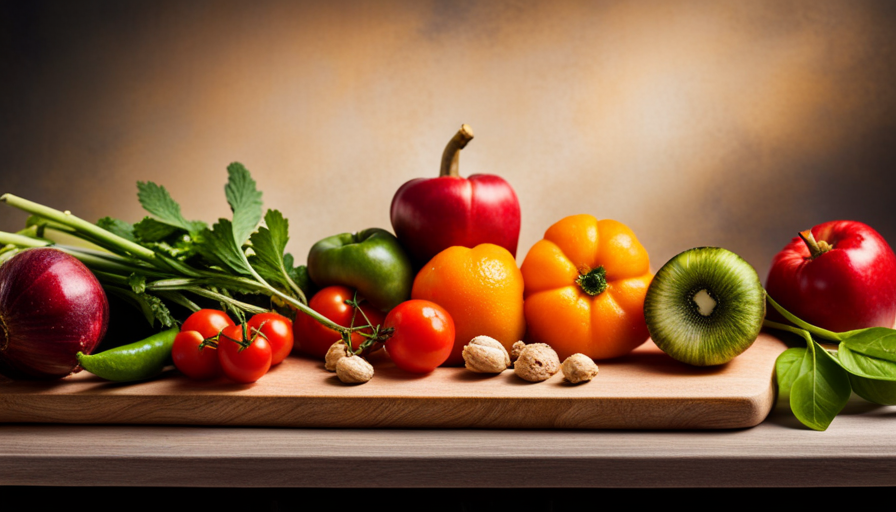Have you ever wondered how much raw food is the right amount to feed your beloved pet?
Imagine this scenario: you have recently transitioned your dog to a raw food diet and you want to ensure they are getting the right amount of nutrients. Understanding the principles of raw feeding is crucial for providing your pet with a balanced and nourishing diet.
In this article, we will explore the scientific and evidence-based approach to determining the appropriate amount of food for your pet. By assessing their nutritional needs, calculating their daily caloric requirement, and adjusting portion sizes based on weight, activity level, and age, you can ensure that your pet is receiving the optimal amount of food.
We will also address common feeding challenges and concerns, and provide guidance on how to safely transition to a raw feeding diet. Remember, consulting with a veterinary professional is always recommended to ensure the specific needs of your pet are met.
Key Takeaways
- Proper food preparation and hygiene practices are important in raw feeding to prevent bacterial contamination.
- Portion sizes for raw feeding should be determined based on your pet’s weight, body condition, metabolic rate, and activity level.
- Portion sizes should be adjusted for puppies, who have higher energy needs, and senior dogs, who have lower energy requirements.
- Consultation with a veterinarian is recommended to ensure your pet’s specific needs are met and to make any necessary adjustments.
Understanding the Principles of Raw Feeding
So, you’re interested in raw feeding and want to understand the principles behind it, right?
Raw feeding has gained popularity among pet owners due to its potential benefits. Advocates claim that feeding a raw diet can improve overall health, enhance digestion, and increase energy levels in pets. However, it’s important to note that scientific evidence supporting these claims is still limited.
Proper food preparation is crucial when it comes to raw feeding. It involves selecting high-quality ingredients that meet the nutritional needs of your pet. The diet should consist of raw meat, bones, organs, and a small amount of fruits and vegetables. It’s important to ensure that the ingredients are sourced from reputable sources to minimize the risk of contamination.
When preparing raw food for your pet, it’s essential to follow proper hygiene practices to prevent the spread of harmful bacteria. This includes washing your hands and utensils thoroughly after handling raw meat and storing the food at the correct temperature to prevent bacterial growth.
Understanding the principles of raw feeding is essential before incorporating it into your pet’s diet. While there may be potential benefits, it’s important to consult with a veterinarian and gather scientific evidence to make informed decisions about your pet’s nutrition.
Assessing Your Pet’s Nutritional Needs
When considering your pet’s dietary requirements, it’s crucial to assess their nutritional needs to ensure their overall health and well-being. Assessing nutritional deficiencies and choosing appropriate protein sources are key factors in providing a balanced raw food diet for your pet.
One way to assess your pet’s nutritional needs is by examining their body condition. A body condition score can help determine if your pet is underweight, overweight, or at an ideal weight. This assessment can guide you in adjusting their food intake accordingly. Additionally, it’s important to consider the specific needs of your pet’s breed, age, and activity level. Puppies, for example, require more protein and calories compared to adult dogs.
When it comes to choosing appropriate protein sources, variety is key. Different protein sources provide different essential nutrients. For example, fish is rich in omega-3 fatty acids, while beef and chicken are excellent sources of essential amino acids. Incorporating a variety of protein sources into your pet’s diet can help prevent nutritional deficiencies.
To further illustrate the importance of assessing nutritional needs and choosing appropriate protein sources, consider the following table:
| Protein Source | Essential Nutrients |
|---|---|
| Fish | Omega-3 fatty acids |
| Beef | Essential amino acids |
| Chicken | Essential amino acids |
| Lamb | Iron and zinc |
By carefully assessing your pet’s nutritional needs and choosing appropriate protein sources, you can provide them with a balanced raw food diet that supports their overall health and well-being.
Determining the Daily Caloric Requirement
To truly impress your pet with your culinary skills, it’s time to calculate their daily caloric requirement. Determining the right amount of food to feed your pet is crucial for their overall health and well-being. Daily calorie intake is a key factor in maintaining a balanced diet and preventing both obesity and malnutrition.
Feeding guidelines can vary depending on factors such as age, weight, and activity level. To calculate the daily caloric requirement, you should first determine your pet’s ideal body weight. This can be done by consulting with your veterinarian or using weight charts provided by reputable sources.
Once you have the ideal weight, you can use a formula to calculate the daily calorie intake based on your pet’s activity level. It’s important to note that these calculations are just a starting point. You should closely monitor your pet’s weight and adjust the amount of food accordingly. Regular check-ups with your veterinarian can also help ensure that your pet’s nutritional needs are being met.
By carefully calculating your pet’s daily caloric requirement and following feeding guidelines, you can provide them with a well-balanced diet that supports their overall health and happiness.
Calculating Portion Sizes Based on Weight
Determining your pet’s portion sizes based on their weight is like creating a perfectly tailored outfit that accentuates their unique shape and keeps them looking and feeling their best. Weight-based calculations are crucial for accurate portioning when it comes to raw feeding. Following a scientific and evidence-based approach ensures that your pet receives the right amount of food to maintain a healthy weight.
To accurately calculate portion sizes based on weight, consider the following factors:
-
Body Condition: Assess your pet’s body condition score, which is an indicator of their overall health and weight. This score helps determine whether your pet needs to gain or lose weight.
-
Metabolic Rate: Consider your pet’s individual metabolic rate. Some pets have a higher metabolism and require more food, while others have a slower metabolism and need fewer calories.
-
Activity Level: Take into account your pet’s activity level. More active pets will require more food to fuel their energy needs, while less active pets may need smaller portions to prevent weight gain.
By incorporating weight-based calculations into your raw feeding routine, you can ensure accurate portioning that meets your pet’s unique needs. Remember to consult with your veterinarian for personalized advice and to monitor your pet’s weight regularly for any necessary adjustments.
Adjusting Portions for Activity Level and Age
Adjusting portion sizes for your pet’s activity level and age is essential to ensure they are receiving the appropriate amount of nourishment to support their energy needs and overall health. Puppies require different portion sizes compared to adult dogs due to their rapid growth and higher energy expenditure. It is recommended to consult with your veterinarian to determine the specific portion sizes for your puppy based on their breed, weight, and age.
For puppies, it is important to divide their daily food intake into multiple smaller meals throughout the day to aid digestion and prevent bloating. As they grow, their portion sizes can gradually increase to meet their growing needs. On the other hand, senior dogs have lower energy requirements and may need smaller portion sizes to prevent weight gain and maintain a healthy body condition. Adjusting portion sizes for senior dogs can help prevent obesity and reduce the risk of age-related health issues such as arthritis and diabetes.
To help you visualize the recommended portion sizes for puppies and senior dogs, consider the following table:
| Age Group | Portion Size |
|---|---|
| Puppies | 3-4% of body weight |
| Seniors | 1.5-2% of body weight |
Remember, these are general guidelines, and individual factors such as breed, activity level, and health condition should also be considered when determining the appropriate portion sizes for your pet. Regular monitoring of your pet’s weight and body condition can help you make adjustments as needed to ensure they are receiving the right amount of food for their age and activity level.
Incorporating Variety in the Raw Diet
When it comes to nourishing your pet, it’s important to spice things up and add a pinch of variety to their diet, just like adding a dash of flavor to your own meals. Incorporating variety in the raw diet can provide numerous benefits for your furry friend.
Raw feeding allows you to offer a wide range of proteins, including beef, chicken, turkey, fish, and organ meats. This variety ensures that your pet receives a well-rounded nutrient profile, as different proteins contain different essential amino acids and vitamins.
Incorporating variety also helps prevent nutrient deficiencies and sensitivities. By rotating proteins, you can reduce the risk of your pet developing an intolerance to a specific protein source. Additionally, different proteins offer different micronutrient profiles, ensuring that your pet receives a diverse array of vitamins and minerals.
To incorporate variety in the raw diet, you can alternate between different protein sources, such as beef, chicken, and fish, throughout the week or month. You can also include a variety of organ meats, such as liver, heart, and kidney, to provide an additional nutrient boost. Remember to consult with a veterinarian or a veterinary nutritionist to ensure that you are providing a balanced and complete diet for your pet.
Incorporating variety in the raw diet is crucial for your pet’s overall health and wellbeing. By offering a diverse range of proteins and organ meats, you can provide a nutrient-rich diet that promotes optimal nutrition and prevents nutrient deficiencies.
Monitoring Your Pet’s Body Condition
Keeping an eye on your pet’s body condition is essential to ensure they’re maintaining a healthy weight and overall well-being. Monitoring your pet’s weight is crucial in determining if they’re at their ideal weight or if adjustments need to be made to their raw diet.
To assess their body condition, you can use a body condition scoring system developed by veterinarians. This system evaluates the amount of fat covering the ribs, spine, and waistline. By regularly checking your pet’s body condition, you can identify any changes and make necessary adjustments to their feeding routine.
When it comes to raw feeding, it’s important to remember that portion sizes may vary depending on your pet’s weight and activity level. If your pet’s overweight, you may need to reduce their food intake slightly to help them reach their ideal weight. On the other hand, if your pet’s underweight, you may need to increase their food portions to promote healthy weight gain. However, it’s crucial to consult with your veterinarian before making any significant changes to your pet’s diet.
In addition to monitoring your pet’s weight, it’s also essential to observe their overall well-being. Look for signs of lethargy, excessive thirst, or changes in appetite, as these could indicate underlying health issues. By keeping a close eye on your pet’s body condition, you can ensure they’re healthy and thriving on their raw food diet.
Addressing Feeding Challenges and Concerns
One common challenge pet owners may face is introducing new textures and flavors to their pet’s diet, such as adding chopped vegetables or fresh fruits to their meals. For example, a pet owner may notice that their dog is hesitant to eat raw carrots initially, but with patience and consistency, the dog eventually develops a taste for them and eagerly includes them in their meals.
To address feeding challenges and concerns, it’s important to consider the following:
-
Gradual introduction: Introduce new foods slowly to allow your pet to adjust to the new flavors and textures. Start with small amounts and gradually increase the quantity over time.
-
Variety is key: Ensure that your pet’s diet is balanced and includes a variety of proteins, fruits, vegetables, and supplements to provide all the necessary nutrients.
-
Consult with a veterinarian: If you have concerns about your pet’s feeding habits or if they’re refusing to eat certain foods, it’s recommended to consult with a veterinarian to rule out any underlying health issues.
-
Training and positive reinforcement: Use positive reinforcement techniques to encourage your pet to try new foods. Reward them with praise or treats when they show interest in new flavors or textures.
-
Patience and consistency: It may take time for your pet to adjust to new foods. Be patient and consistent in offering them a variety of options, and eventually, they may develop a taste for different foods.
By addressing feeding challenges and concerns with these strategies, pet owners can ensure that their pets receive a balanced and nutritious diet.
Consulting with a Veterinary Professional
Consulting with a vet is crucial for ensuring your furry friend’s health and well-being. When it comes to raw feeding, seeking veterinary guidance and professional advice is essential. A qualified veterinarian can provide you with the necessary information and guidance to ensure that your pet’s nutritional needs are met and that they are receiving a balanced diet.
One way a veterinary professional can assist you is by helping you determine the appropriate amount of food to feed your pet. They can take into account factors such as your pet’s age, weight, activity level, and overall health to provide personalized recommendations. Feeding too little can result in malnutrition, while feeding too much can lead to obesity and other health issues.
To give you an idea of the recommended feeding amounts for dogs based on their weight, here is a table:
| Weight Range (lbs) | Daily Feeding Amount (oz) |
|---|---|
| 10-20 | 2-5 |
| 20-40 | 5-10 |
| 40-60 | 10-15 |
| 60-80 | 15-20 |
| 80+ | 20+ |
It’s important to remember that these amounts are just general guidelines, and individual needs may vary. Consulting with a veterinary professional will ensure that your pet’s unique needs are met and that they thrive on a raw food diet.
Transitioning to a Raw Feeding Diet Safely
Navigating the path towards a raw feeding diet for your furry companion is like venturing into uncharted territory, but with the right guidance and precautions, your pet can safely embark on this transformative culinary journey.
When transitioning to a raw feeding diet, it’s important to follow some key tips to ensure a smooth and safe transition. Firstly, start by gradually introducing raw food into your pet’s diet, mixing it with their current food and increasing the proportion of raw food over time. This helps their digestive system adjust to the new diet.
Additionally, it’s crucial to provide a balanced and varied raw diet to ensure your pet receives all the necessary nutrients. Including a variety of meats, bones, organs, and even some fruits and vegetables can help achieve this balance.
While transitioning to a raw diet can have numerous benefits for your pet’s health, it’s essential to be aware of potential risks. Raw food carries a higher risk of bacterial contamination, so it’s crucial to handle and store raw food properly to minimize the risk of foodborne illnesses.
It’s also important to consult with a veterinary professional to ensure that your pet’s specific nutritional needs are met and to address any concerns or potential health issues. By following these transitioning tips and being aware of potential risks, you can safely introduce your pet to a raw feeding diet and provide them with the nutrition they need for optimal health.
Frequently Asked Questions
Can I feed my pet a combination of raw and commercial pet food?
Yes, you can feed your pet a combination of raw and commercial pet food. There are benefits to both types of food. Raw food provides natural nutrients and enzymes, while commercial pet food is convenient and often balanced. However, there are also risks associated with raw feeding, such as bacterial contamination. It’s important to consult with a veterinarian to ensure a balanced diet and minimize potential risks.
How often should I feed my pet on a raw feeding diet?
To establish a feeding schedule for your pet on a raw feeding diet, it’s crucial to consider portion sizes. It’s recommended to divide their daily portion into two or three meals, depending on their age and activity level.
Puppies require more frequent meals, while adult dogs can usually manage with two. As for portion sizes, it’s advised to feed approximately 2-3% of their body weight per day, adjusting as needed to maintain a healthy weight.
Are there any specific guidelines for feeding raw food to puppies or kittens?
When it comes to feeding raw food to puppies or kittens, there are specific guidelines that should be followed. These guidelines are based on scientific evidence and specialized knowledge in animal nutrition.
It’s important to provide a balanced diet with the right proportions of protein, fat, and carbohydrates. Additionally, portion sizes should be appropriate for the age and size of the animal.
Consulting with a veterinarian or an animal nutritionist can help ensure that you’re meeting the specific needs of your growing pet.
Can I feed my pet a raw diet if they have specific dietary restrictions or allergies?
If your pet has specific dietary restrictions or allergies, you can still feed them a raw diet with careful consideration. A raw diet can eliminate common allergens found in processed pet foods and support a healthy digestive system. It can also improve nutrient absorption. However, it’s crucial to work closely with a veterinarian or a veterinary nutritionist to ensure that your pet’s specific dietary needs are met while feeding them a raw diet.
Is it necessary to include supplements in my pet’s raw feeding diet?
Supplement alternatives aren’t necessary in a raw feeding diet for your pet. A well-balanced raw diet can provide all the necessary nutrients, contrary to popular misconceptions. Research has shown that the natural ingredients in raw food can adequately meet your pet’s nutritional needs. By sourcing high-quality ingredients and varying the protein sources, you can ensure a nutrient-rich diet.
However, it’s always advisable to consult with a veterinarian to tailor the diet to your pet’s specific needs.
What is the Proper Amount of Raw Food to Feed to a Pet?
When it comes to feeding raw food amounts to pets, it’s important to strike a balance. The general recommendation is to feed 2-3% of your pet’s body weight in raw food daily. However, it’s essential to consult with a veterinarian to determine the proper amount based on your pet’s specific needs.
Conclusion
So, there you have it – a comprehensive guide to raw feeding for your furry friend. By understanding the principles and assessing your pet’s needs, you can determine the right amount of food to provide. Remember to calculate portion sizes based on weight, adjust for activity level and age, and monitor your pet’s body condition.
If you encounter any challenges or concerns, don’t hesitate to consult with a veterinary professional. With proper guidance and a safe transition, your pet can thrive on a raw feeding diet. Happy feeding, and may your pet’s health be furr-midable!










